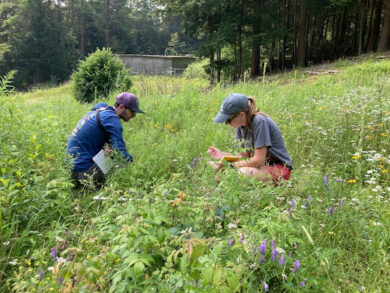By: Ron Smith and Ryan Rebozo

Educators survey vegetation during the second Science Teacher Workshop ©Ryan Rebozo
A few feet off a trail, a quadrat was placed randomly among the vegetation. Just how much plant life exists in a square meter?
This was the first field experience during the second annual VCE Community Science Teacher Workshop. Vermont and New Hampshire educators alike joined to explore field methods and focus on enhancing science in their curriculums. Our goals for the workshop aimed to give teachers the toolkit to engage students in the outdoors and develop place-based community science that addresses both local and regional conservation issues. Educators explored a range of sampling techniques and methods involving invertebrates, birds, forest ecology, conservation, and climate change. Collaboration and engagement with VCE staff, along with interaction and sharing with a community of educators, made for an exciting opportunity to explore the applications of field methods and the promise of partnerships going forward.
This workshop was made possible by funding from the New Hampshire Charitable Foundation’s Wellborn Ecology Fund and Hypertherm’s Hope Foundation. Our funders not only supported the program itself but also made it possible to provide stipends to participants. We are working to ensure that our Community Science Teacher Workshop becomes a yearly offering that grows to connect more teachers interested in place-based education and facilitates the sharing of ideas and opportunities.
VCE’s projects show just how powerful community science data can be. Because of this, we want to share our excitement about community-sourced data with local teachers who will then spread this to our next cohort of community scientists- their students. If you are interested in learning more about future workshop offerings or how to contribute to or use VCE data in the classroom reach out to VCE Director of Conservation Science Ryan
